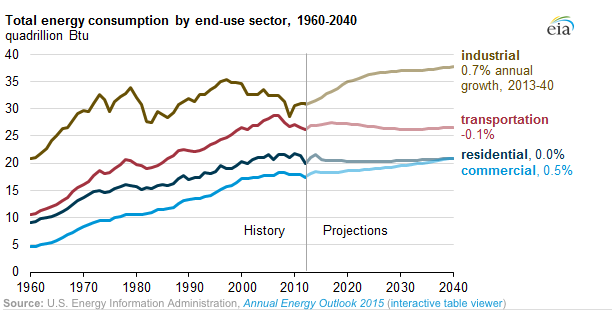Energy consumption in the U.S., which has slowed recently, is projected to inch up by only 0.3% per year through 2040, which would be less than half the projected population growth rate over that period.
In its Annual Energy Outlook 2015, the U.S. Energy Information Administration (EIA) elaborates that industrial energy consumption over the next 25 years will be slightly higher, at 0.7% per year, while annual commercial consumption is expected to be 0.5%.
EIA attributes these consumption reductions to the adoption of energy efficient technologies, as well as “larger structural changes in the economy.” For example, residential consumption has slowed as more people have moved to warmer climates. And policies that have mandated better fuel efficiencies in cars and trucks appear to be having a positive effect.
“These standards, combined with less travel in response to technological and social factors, have reduced transportation energy consumption in recent years and are expected to continue holding transportation consumption nearly flat in the coming decades,” EIA observes.

The department points to several factors that are expected to shape U.S. energy markets in the next generation. These include:
- Growth in U.S. energy production, coupled with only modest increases in domestic demand, will further reduce the country’s reliance on imported energy suppliers. EIA anticipates that energy imports and exports “come into balance” in the U.S. starting in 2028.
- The U.S. will transition from being a modest net importer of natural gas to a net exporter by 2017, with net exports in 2040 ranging from 3 trillion cubic feet (in a low-oil-price scenario) to 13.1 million (in a high oil and gas resource scenario).
- Rising costs for electric power generation, transmission, and distribution, along with slower growth in electricity demand, are expected to lead to an 18% increase in the average retail price of electricity between 2013 and 2040.
- End-user efficiencies are expected to keep energy related carbon dioxide emissions in the U.S. below 2005 levels through 2040.
EIA expects net energy exports to contribute more to the country’s GDP growth than it has in the previous 30 years, partly because of reduced imports. But that impact is also expected to diminish in the later years of this projection cycle, as GDP growth in nations that are U.S. trade partners slows.
Related Stories
Market Data | Mar 14, 2024
Download BD+C's March 2024 Market Intelligence Report
U.S. construction spending on buildings-related work rose 1.4% in January, but project teams continue to face headwinds related to inflation, interest rates, and supply chain issues, according to Building Design+Construction's March 2024 Market Intelligence Report (free PDF download).
Apartments | Mar 13, 2024
A landscaped canyon runs through this luxury apartment development in Denver
Set to open in April, One River North is a 16-story, 187-unit luxury apartment building with private, open-air terraces located in Denver’s RiNo arts district. Biophilic design plays a central role throughout the building, allowing residents to connect with nature and providing a distinctive living experience.
Sustainability | Mar 13, 2024
Trends to watch shaping the future of ESG
Gensler’s Climate Action & Sustainability Services Leaders Anthony Brower, Juliette Morgan, and Kirsten Ritchie discuss trends shaping the future of environmental, social, and governance (ESG).
Affordable Housing | Mar 12, 2024
An all-electric affordable housing project in Southern California offers 48 apartments plus community spaces
In Santa Monica, Calif., Brunson Terrace is an all-electric, 100% affordable housing project that’s over eight times more energy efficient than similar buildings, according to architect Brooks + Scarpa. Located across the street from Santa Monica College, the net zero building has been certified LEED Platinum.
Museums | Mar 11, 2024
Nebraska’s Joslyn Art Museum to reopen this summer with new Snøhetta-designed pavilion
In Omaha, Neb., the Joslyn Art Museum, which displays art from ancient times to the present, has announced it will reopen on September 10, following the completion of its new 42,000-sf Rhonda & Howard Hawks Pavilion. Designed in collaboration with Snøhetta and Alley Poyner Macchietto Architecture, the Hawks Pavilion is part of a museum overhaul that will expand the gallery space by more than 40%.
Affordable Housing | Mar 11, 2024
Los Angeles’s streamlined approval policies leading to boom in affordable housing plans
Since December 2022, Los Angeles’s planning department has received plans for more than 13,770 affordable units. The number of units put in the approval pipeline in roughly one year is just below the total number of affordable units approved in Los Angeles in 2020, 2021, and 2022 combined.
BIM and Information Technology | Mar 11, 2024
BIM at LOD400: Why Level of Development 400 matters for design and virtual construction
As construction projects grow more complex, producing a building information model at Level of Development 400 (LOD400) can accelerate schedules, increase savings, and reduce risk, writes Stephen E. Blumenbaum, PE, SE, Walter P Moore's Director of Construction Engineering.
Sports and Recreational Facilities | Mar 7, 2024
Bjarke Ingels’ design for the Oakland A’s new Las Vegas ballpark resembles ‘a spherical armadillo’
Designed by Bjarke Ingels Group (BIG) in collaboration with HNTB, the new ballpark for the Oakland Athletics Major League Baseball team will be located on the Las Vegas Strip and offer panoramic views of the city skyline. The 33,000-capacity covered, climate-controlled stadium will sit on nine acres on Las Vegas Boulevard.
Adaptive Reuse | Mar 7, 2024
3 key considerations when converting a warehouse to a laboratory
Does your warehouse facility fit the profile for a successful laboratory conversion that can demand higher rents and lower vacancy rates? Here are three important considerations to factor before proceeding.
Shopping Centers | Mar 7, 2024
How shopping centers can foster strong community connections
In today's retail landscape, shopping centers are evolving beyond mere shopping destinations to become vibrant hubs of community life. Here are three strategies from Nadel Architecture + Planning for creating strong local connections.

















